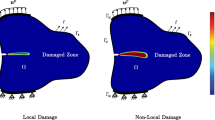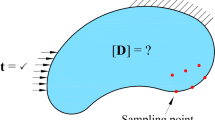Abstract
The identification of a unilateral frictionless crack is performed in nonlinear elastostatics by using boundary measurements for given static loadings. The procedure proposed takes into account the possibility of a partial or total closure of the crack during the identification process; that makes the present formulation more complex than others referred to permanently open cracks. The Linear Complementarity Problem (LCP), which provides at each step contact tractions and relative displacements along the crack, is discretised by means of the Dual Boundary Element Method (DBEM) and solved explicitly by Lemke's algorithm. The identification procedure is based on a first-order nonlinear optimisation technique in which the gradients of the cost function are obtained by solving again a LCP with a considerably reduced number of variables. Some numerical examples show the applicability of the method.
Similar content being viewed by others
Author information
Authors and Affiliations
Additional information
Received 23 November 1998
Rights and permissions
About this article
Cite this article
Alessandri, C., Mallardo, V. Crack identification in two-dimensional unilateral contact mechanics with the boundary element method. Computational Mechanics 24, 100–109 (1999). https://doi.org/10.1007/s004660050442
Issue Date:
DOI: https://doi.org/10.1007/s004660050442




